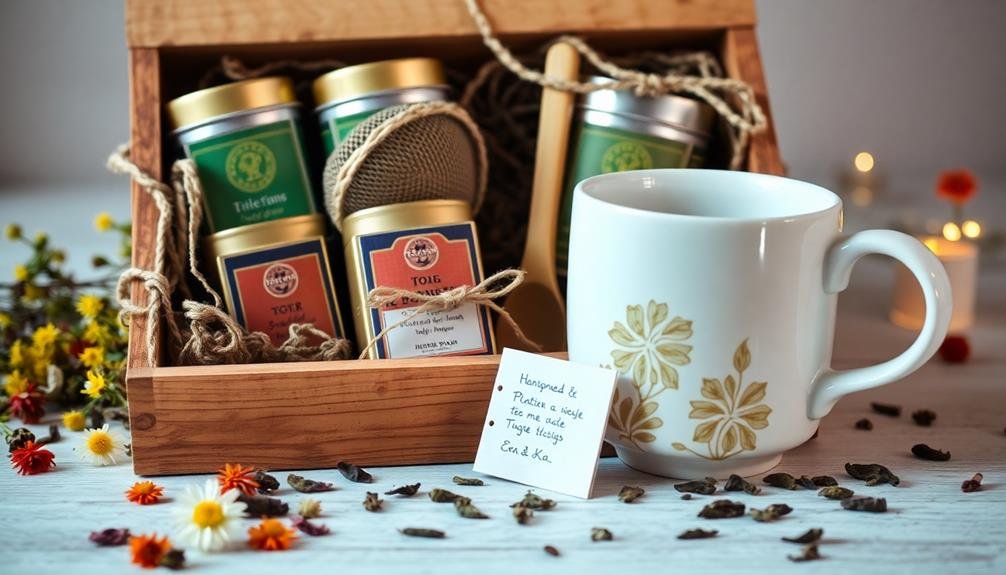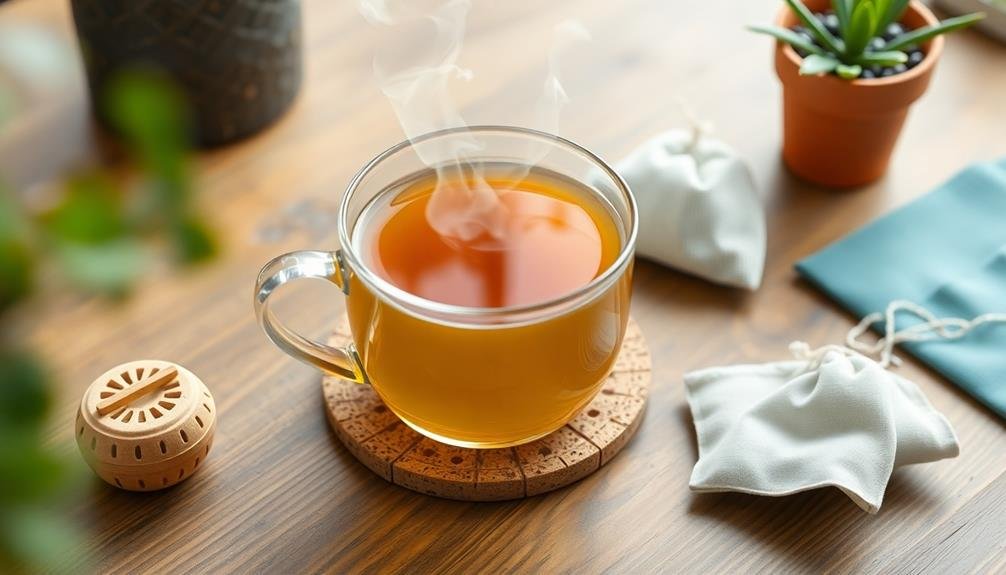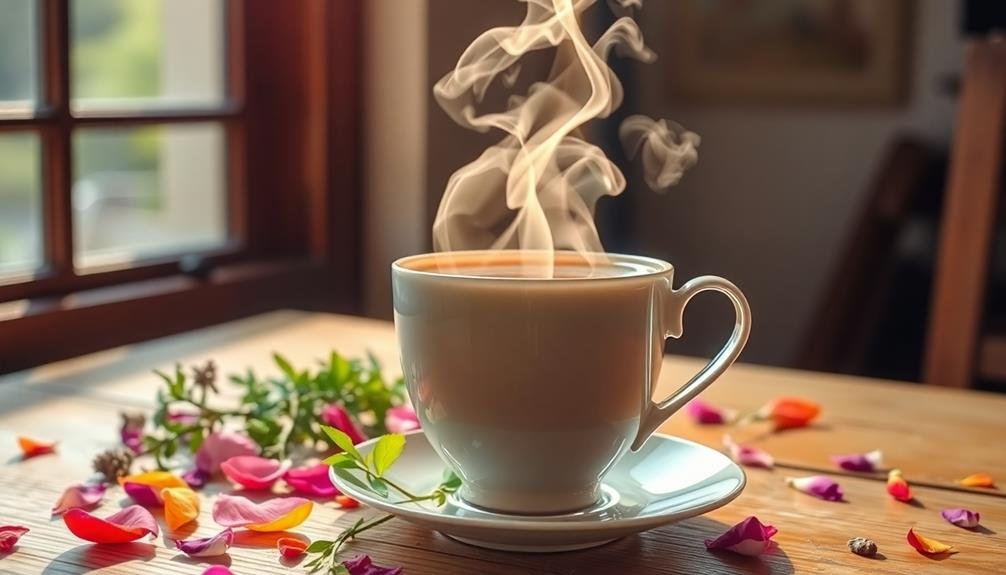Crafting homemade herbal tea blends offers numerous benefits, including control over ingredients, cost-effectiveness, and freshness. You'll need essential equipment like airtight jars, a digital scale, and tea infusers to get started. Choose high-quality, organic herbs from reputable sources or grow your own. When creating custom tea bags, select food-safe filter materials and measure herbs precisely. Popular medicinal blends include immune-boosting, calming, and digestive aid recipes. Proper storage in airtight containers away from light and heat guarantees longevity. Most blends maintain potency for 6-12 months when stored correctly. By exploring these techniques, you'll reveal a world of natural healing and personalized wellness options.
Benefits of Homemade Herbal Teas

In light of the growing interest in natural remedies, homemade herbal teas offer a range of benefits. When you create your own blends, you're in control of the ingredients, ensuring you're using high-quality, organic herbs without any artificial additives or preservatives. This allows you to tailor your tea to your specific health needs and taste preferences.
Homemade herbal teas are cost-effective, as you can buy herbs in bulk and create multiple blends. They're also fresher than pre-packaged teas, which can lose potency over time. By making your own, you'll enjoy the full flavor and medicinal properties of the herbs.
These teas can support various aspects of your health, from boosting immunity to aiding digestion and promoting relaxation. You can experiment with different combinations to address specific concerns, such as blending chamomile and lavender for sleep or peppermint and ginger for upset stomachs.
Preparing your own herbal teas can be a mindful, relaxing ritual. It connects you with nature and traditional healing practices, fostering a deeper appreciation for the plants' properties.
You'll also develop a better understanding of herbal medicine, empowering you to take charge of your wellness journey.
Essential Equipment for Tea Blending
Enthusiasts starting on their tea-blending journey will need a few key items to get started. First, invest in a set of airtight glass jars to store your dried herbs and finished blends. These containers will keep your ingredients fresh and prevent moisture from compromising their quality.
You'll also need a digital scale to measure your ingredients accurately, guaranteeing consistent results every time. A mortar and pestle are essential for grinding larger herbs and spices, releasing their flavors and aromas.
Don't forget to acquire a set of mesh tea infusers or reusable tea bags for steeping your custom blends. Finally, a notebook or digital app will help you keep track of your recipes and experiments.
Here's a quick list of essential equipment for tea blending:
- Airtight glass jars
- Digital scale
- Mortar and pestle
- Mesh tea infusers or reusable tea bags
- Notebook or recipe-tracking app
With these tools at your disposal, you'll be well-equipped to create and enjoy your own unique herbal tea blends. Remember to source high-quality, organic herbs from reputable suppliers to guarantee the best flavor and medicinal properties in your homemade teas.
Selecting Quality Herbs and Ingredients

Quality is the cornerstone of any great herbal tea blend. When selecting herbs and ingredients for your homemade teas, prioritize freshness and purity. Look for organic, non-irradiated herbs whenever possible to guarantee you're getting the most potent and beneficial compounds.
Start by sourcing your herbs from reputable suppliers or growing them yourself. If you're purchasing dried herbs, they should be vibrant in color and aromatic. Avoid any that appear dull, discolored, or have a musty smell.
For fresh herbs, choose those with crisp leaves and no signs of wilting or damage. Consider the medicinal properties you're aiming for in your blend. Research each herb's benefits and potential interactions before including them.
Don't forget to factor in flavor profiles – a well-balanced tea should be both effective and enjoyable to drink. When incorporating other ingredients like dried fruits, spices, or flowers, apply the same quality standards.
These additions can enhance both the taste and therapeutic value of your blend. Remember, the quality of your ingredients directly impacts the potency and effectiveness of your herbal tea, so invest time in selecting the best possible components.
Crafting Your Custom Tea Bags
Now that you've chosen your herbs, it's time to create your custom tea bags.
You'll need to select appropriate filter materials, such as unbleached paper filters or reusable cloth pouches, to hold your tea blend.
Carefully measure and portion your herbs into each bag, ensuring a consistent flavor across brews.
Then securely seal and store your tea bags in an airtight container to preserve freshness.
Choosing Suitable Filter Materials
For crafting your custom tea bags, selecting the right filter material is essential. You'll want to choose materials that are food-safe, durable, and allow for proper infusion of your herbal blend.
Consider the following options:
- Unbleached muslin cloth
- Cotton cheesecloth
- Disposable paper filters
- Biodegradable corn-based filters
- Reusable cotton or hemp tea bags
When selecting your filter material, think about the size of your tea leaves and herbs. Finely ground blends require a tighter weave to prevent particles from escaping into your cup.
For whole leaf teas, a looser weave allows for better water flow and flavor extraction.
If you're environmentally conscious, opt for reusable or biodegradable options. These choices reduce waste and are often more cost-effective in the long run.
However, if convenience is your priority, disposable filters might be the way to go.
Remember to verify that your chosen material can withstand hot water without breaking down or releasing harmful chemicals.
Always check that the filter material is food-grade and free from any treatments or coatings that could affect the taste or safety of your tea.
Measuring and Portioning Herbs
With your filter material chosen, it's time to focus on the heart of your custom tea bags: the herbs themselves. Accurate measuring and portioning are essential for creating consistently flavorful and effective herbal blends. Start by investing in a small digital scale that measures in grams, as this will provide the most precise measurements.
For single-serving tea bags, aim for 1 to 2 grams of dried herbs per bag. If you're using fresh herbs, double this amount to account for their higher water content. When creating blends, maintain a total weight of 1 to 2 grams, adjusting the ratios of individual herbs to achieve your desired flavor and medicinal properties.
Use measuring spoons for quick portioning: 1 teaspoon of dried herbs typically weighs about 1 gram. However, herb density varies, so rely on your scale for accuracy. When working with potent herbs or those with strong flavors, use smaller amounts, around 1/4 to 1/2 teaspoon per bag.
Store your pre-portioned herbs in airtight containers, labeled with the blend name and date. This practice guarantees freshness and makes it easy to grab the right amount when you're ready to fill your tea bags.
Sealing and Storing Bags
The final step in crafting your custom tea bags is sealing and storing them properly. Once you've measured and portioned your herbs, it's essential to guarantee they remain fresh and potent. Use food-grade, heat-sealable tea bags or filters to contain your blends. If you're using loose tea bags, fold the top over twice and press firmly to create a secure seal.
For long-term storage, consider these tips:
- Store tea bags in airtight containers to prevent moisture and air exposure
- Keep containers in a cool, dark place away from direct sunlight
- Label each container with the blend name and date of preparation
- Use within 6-12 months for ideal freshness and potency
- Consider vacuum-sealing larger batches for extended shelf life
When you're ready to use a tea bag, simply remove it from storage and steep in hot water according to your preferred strength.
Remember that proper sealing and storage not only preserve the flavor and aroma of your herbal blends but also maintain their medicinal properties. By following these guidelines, you'll guarantee that your custom tea bags remain fresh and effective whenever you need them.
Five Medicinal Tea Blend Recipes

Immerse yourself in the world of homemade medicinal tea blends with these five carefully crafted recipes. Each blend is designed to address specific health concerns and provide natural relief. You'll find a perfect mix for your needs, whether you're looking to boost immunity, calm anxiety, or improve digestion.
| Blend Name | Ingredients |
|---|---|
| Immune Boost | Echinacea, elderberry, ginger |
| Calming Chamomile | Chamomile, lavender, lemon balm |
| Digestive Aid | Peppermint, fennel, licorice root |
| Sleep Well | Valerian root, passionflower, hops |
| Detox Blend | Dandelion root, milk thistle, burdock |
To prepare these blends, mix equal parts of each ingredient in a bowl. Store the mixture in an airtight container away from light and heat. When you're ready to brew, use 1-2 teaspoons of the blend per cup of hot water. Steep for 5-10 minutes, depending on your desired strength. Remember, while these blends can offer natural relief, they're not substitutes for professional medical advice. Always consult your healthcare provider before using medicinal herbs, especially if you're pregnant, nursing, or taking medications.
Proper Storage and Shelf Life
To keep your homemade herbal tea blends fresh and potent, you'll need to store them in airtight containers.
These containers protect your blends from moisture, light, and air, which can degrade the quality and flavor of your teas.
Don't forget to label your containers with the blend name and date, as even properly stored herbal teas have a limited shelf life and will eventually lose their potency.
Airtight Containers for Freshness
Longevity of your homemade herbal tea blends hinges on proper storage. Airtight containers are your best allies in preserving freshness and potency. Choose containers made of materials that block light and air, such as opaque glass jars, ceramic canisters, or metal tins with tight-fitting lids.
When selecting airtight containers for your herbal tea blends, consider these factors:
- Size: Match the container to the amount of tea you're storing
- Material: Opt for non-reactive materials that won't affect taste
- Seal: Guarantee a tight seal to prevent air and moisture infiltration
- Opacity: Dark or opaque containers protect against light degradation
- Practicality: Choose containers that are easy to open and close
Label your containers with the blend's name, ingredients, and date of preparation. This practice helps you track freshness and rotation.
Store your containers in a cool, dry place away from direct sunlight and heat sources. Avoid areas prone to temperature fluctuations or high humidity, such as near stoves or in bathrooms.
Expiration Dates Matter
Despite your best efforts in storage, herbal tea blends won't last forever. It's essential to understand the shelf life of your homemade teas and respect expiration dates. Most dried herbs and flowers maintain their potency for 6-12 months when stored properly. However, some ingredients may degrade faster, affecting the overall quality of your blend.
To guarantee you're drinking the freshest and most effective tea, label your containers with the date of creation and a "best by" date. Use the following table as a general guide for common herbal tea ingredients:
| Ingredient | Ideal Shelf Life | Signs of Spoilage |
|---|---|---|
| Chamomile | 9-12 months | Loss of aroma |
| Peppermint | 6-9 months | Faded color |
| Lavender | 6-12 months | Musty smell |
| Ginger | 12-18 months | Lack of spiciness |
Frequently Asked Questions
Can I Use Fresh Herbs Instead of Dried Ones in My Tea Blends?
Yes, you can use fresh herbs in your tea blends. They'll provide a more vibrant flavor, but you'll need to use more. Remember, fresh herbs contain water, so adjust your measurements accordingly. Experiment to find your perfect balance.
Are There Any Herbs That Should Not Be Mixed Together?
You'll want to avoid mixing certain herbs together. Some combinations can be harmful or reduce effectiveness. For example, don't mix St. John's Wort with antidepressants or chamomile with blood thinners. Always research potential interactions before blending herbs.
How Long Should I Steep Homemade Herbal Tea Blends?
You'll want to steep your homemade herbal tea blends for 5-10 minutes. However, it's best to follow specific instructions for each herb, as steeping times can vary. Don't oversteep, as it may result in a bitter taste.
Can I Reuse Tea Bags Made With Homemade Herbal Blends?
You can reuse homemade herbal tea bags, but they'll lose flavor with each steeping. For best results, use them twice at most. The second brew might be weaker, so you may want to steep it longer.
Are There Any Potential Side Effects of Drinking Homemade Herbal Teas Regularly?
You should be aware of potential side effects when drinking herbal teas regularly. They can interact with medications, cause allergic reactions, or have unwanted effects if consumed in large quantities. Always research herbs and consult a doctor if you're unsure.
In Summary
You've now got the knowledge to create your own medicinal herbal tea blends. Don't be afraid to experiment with different combinations and flavors. Remember to store your teas properly to maintain their potency and freshness. As you sip your homemade brews, you'll enjoy both the health benefits and the satisfaction of crafting something unique. Keep exploring the world of herbal teas, and you'll always have a comforting cup at hand.





Leave a Reply